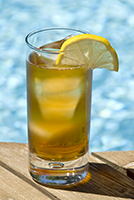Introduction
 Picture this scene: You are sitting by the pool on a bright, sunny July day drinking an ice-cold glass of tea. As you sip your refreshing drink, you begin to examine it more closely. On the outside of the glass, water droplets are beginning to run down the side. Inside the glass are a liquid and a solid -- the liquid tea and the frozen ice cubes. Sitting out under the heat of the sun, this ice-cold tea is rather refreshing! Ahh!
Picture this scene: You are sitting by the pool on a bright, sunny July day drinking an ice-cold glass of tea. As you sip your refreshing drink, you begin to examine it more closely. On the outside of the glass, water droplets are beginning to run down the side. Inside the glass are a liquid and a solid -- the liquid tea and the frozen ice cubes. Sitting out under the heat of the sun, this ice-cold tea is rather refreshing! Ahh!
Now, let's think of this from a science perspective. All the components of your drink -- the glass, condensation, tea, and ice cubes -- are matter! Matter is anything that has mass and takes up space. The glass is a solid that keeps the liquid tea inside. However, as you sit in the hot sun, the liquid is evaporating into a gas and the ice is melting from a solid to a liquid. This is just one example of how matter can change states.
In this unit, we'll learn about the 5 states of matter and how they can be distinguished based on particle motion.
| Lesson Objectives |
|
Following successful completion of this lesson, students will be able to...
Enduring Understandings
The above objectives correspond with the Alabama Course of Study: Physical Science standards: 1 This lesson incorporates the following Literacy Standards: R1, R2, R3, R4, R5, R6, R10, W1, W2, W3, W4, W9, and W10. |
